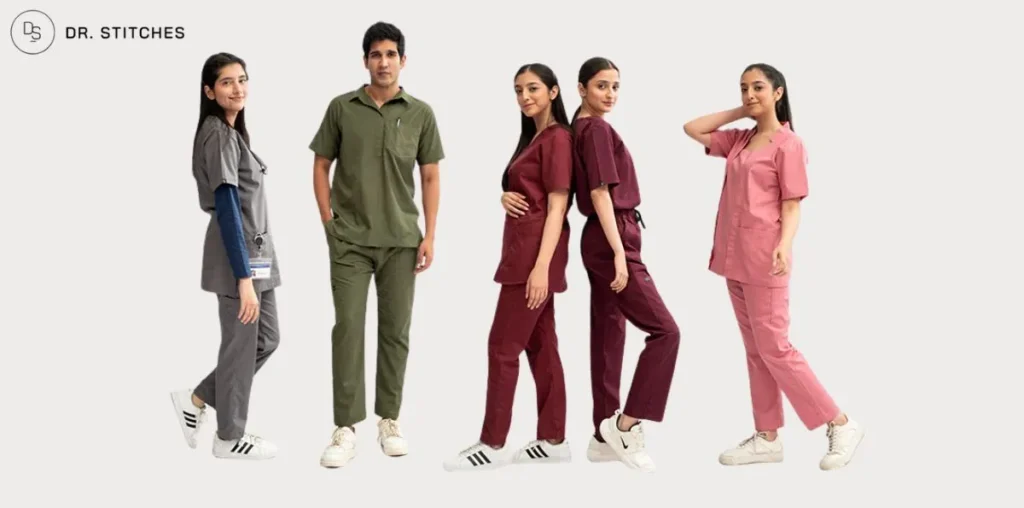Scrubs clothing has become an essential part of the healthcare industry, providing professionals with a comfortable, functional, and hygienic work attire. Initially designed to maintain sterility in surgical environments, scrubs have evolved into a staple for doctors, nurses, and other medical personnel. Over time, advancements in fabric technology and design have transformed scrubs from simple attire into stylish and performance-enhancing workwear. Whether in hospitals, clinics, or private practices, scrubs clothing ensures that healthcare professionals can focus on their patients while maintaining a professional appearance.
The History and Evolution of Scrubs
Scrubs have come a long way since their inception. Before the 20th century, doctors and nurses primarily wore white coats over their clothes. However, concerns about hygiene and contamination led to the development of specialized uniforms. The first scrubs were introduced in the early 20th century as green surgical gowns worn by surgeons to reduce eye strain and enhance focus in bright operating rooms.
By the 1970s, scrubs became widely adopted across various medical fields, replacing traditional uniforms. Hospitals recognized the benefits of lightweight, easy-to-clean fabrics, which improved hygiene and reduced the risk of infection. Today, scrubs are available in numerous colors, patterns, and fabric blends, offering both functionality and aesthetic appeal.
Why Scrubs Clothing is Essential for Healthcare Professionals
Scrubs clothing plays a crucial role in healthcare settings for several reasons:
- Hygiene and Infection Control: Scrubs are designed with antimicrobial properties that help reduce the spread of bacteria and viruses. They are also easy to clean and disinfect, making them ideal for maintaining a sterile environment.
- Comfort and Flexibility: Healthcare professionals work long hours, often standing or moving continuously. Modern scrubs are made from breathable fabrics with moisture-wicking properties, ensuring comfort during extended shifts.
- Professional Appearance: Scrubs provide a standardized and professional look for medical teams. Many healthcare institutions assign different colors or patterns to various departments, making it easier to identify personnel roles.
- Convenience and Functionality: Scrubs feature multiple pockets for storing essential tools such as pens, notepads, thermometers, and medical instruments, allowing professionals to keep necessary items within reach.
- Affordability and Accessibility: Unlike traditional uniforms, scrubs are relatively affordable and easy to replace. They are widely available in various styles and price ranges, catering to different needs and budgets.
Types of Scrubs Clothing
Healthcare professionals can choose from a variety of scrub designs based on their work environment and personal preferences. Some common types include:
1. Basic Scrubs
Basic scrubs consist of a simple V-neck top and drawstring or elastic waist pants. These are ideal for general medical practitioners and nursing staff.
2. Surgical Scrubs
Designed specifically for operating rooms, surgical scrubs are made from high-quality, fluid-resistant materials. They are usually solid in color and have minimal seams to reduce contamination risks.
3. Fashion Scrubs
Modern scrubs feature stylish cuts, vibrant colors, and printed patterns, allowing healthcare workers to express their personalities while maintaining a professional look.
4. Maternity Scrubs
Maternity scrubs offer extra room and stretchable panels to accommodate pregnant healthcare workers, ensuring comfort throughout their shifts.
5. Specialty Scrubs
Certain medical fields, such as pediatrics or veterinary medicine, require specialized scrubs with unique designs, such as cartoon prints or animal patterns, to create a friendly atmosphere for patients.
Choosing the Right Scrubs Clothing
When selecting scrubs, healthcare professionals should consider the following factors:
- Fabric Material – Opt for high-quality fabrics like cotton blends, polyester, or spandex for durability and breathability.
- Fit and Comfort – A well-fitted scrub ensures ease of movement without being too tight or loose.
- Pockets and Storage – Additional pockets provide convenience for carrying medical tools and personal items.
- Color and Design – Consider hospital policies on color coding and personal style preferences.
- Easy Maintenance – Scrubs should be machine washable, stain-resistant, and quick-drying for daily wear.
Caring for Scrubs to Ensure Longevity
Proper care and maintenance of scrubs clothing are essential for hygiene and durability. Here are some tips to keep scrubs in excellent condition:
- Wash Separately – Clean scrubs separately from regular clothes to avoid contamination.
- Use Hot Water and Disinfectants – Washing scrubs in hot water with antimicrobial detergents ensures thorough sanitation.
- Avoid Harsh Chemicals – Bleach and other strong chemicals can weaken the fabric and fade colors.
- Dry Properly – Air-dry or tumble dry on low heat to prevent fabric shrinkage.
- Store in a Clean Space – Keep scrubs in a dedicated, clean area to maintain sterility.
The Future of Scrubs Clothing
The medical apparel industry is continuously evolving, incorporating innovative fabrics and designs to enhance performance and comfort. Some emerging trends in scrubs clothing include:
- Antimicrobial and Odor-Resistant Fabrics – New fabric technologies help prevent bacterial growth and reduce odors, ensuring fresher scrubs throughout shifts.
- Smart Scrubs – Some manufacturers are developing scrubs with built-in technology, such as temperature regulation and heart rate monitoring features.
- Eco-Friendly Scrubs – With sustainability in focus, many brands now offer scrubs made from recycled materials and organic cotton.
- Customized Scrubs – Personalized scrubs with embroidered names, hospital logos, or custom designs are gaining popularity.
Conclusion
Scrubs clothing is more than just a uniform; it is an essential component of healthcare professionals’ daily lives. It provides comfort, hygiene, and functionality, enabling medical staff to perform their duties efficiently. As the demand for high-quality medical attire continues to grow, innovations in scrubs clothing will further improve the experience for healthcare workers worldwide. Whether choosing basic or fashion-forward designs, the right scrub suit for doctors can make a significant difference in both performance and appearance.



